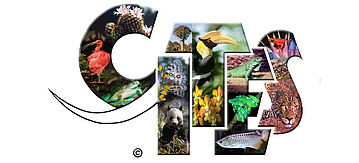CITES

The Convention on International Trade in Endangered Species of Wild Fauna and Flora (CITES), also known as the Washington Convention, was adopted in 1973 as a result of the dramatic decline of many species due to poaching and international trade. Germany was one of the first signatories. CITES entered into force internationally in 1975. Its provisions were implemented in Germany just one year later.
Today, there are 184 parties to the Convention, representing nearly 95 percent of all the world’s countries. It currently covers around 6,610 animal and 34,310 plant species. These numbers reflect the success of the convention, but they also highlight the crisis of biodiversity loss. According to scientists, one million species are or will be threatened with extinction in the coming decades. For wild fauna and flora, international trade remains a key cause of this threat, which can only be combatted through international cooperation.
Despite its title ("Trade"), CITES is not a trade agreement but an agreement designed to protect animals and plants, not only as our natural foundation of life, but also as our fellow living creatures. The preamble to the Convention states that it serves:
- to protect "wild fauna and flora in their many beautiful and varied forms [which] are an irreplaceable part of the natural systems of the earth"
- to preserve the "value of wild fauna and flora from aesthetic, scientific, cultural, recreational and economic points of view"
- "for this and the generations to come".
The precautionary principle is at the heart of the Convention. Specimens of a species may only be traded if the conservation status of the species is not endangered. Here, "trade" refers exclusively to trade between different countries (in particular exports and imports), but not to trade within a country or for the Member States of the European Union within the European single market.
Core instruments of the Convention are graduated requirements for import and export permits. The higher the threat level, the more stringent the restrictions on trading in that species. The more endangered a species is, the stricter the trade restrictions are.
There is a general ban on trade for critically endangered species (listed in Appendix I). Exemptions are only permitted under very limited conditions, provided that non-commercial purposes are being pursued (e.g. scientific research) or the specimens were reproduced artificially (e.g. orchids, cacti). Appendix I includes great apes, whales, elephants, rhinos, parrots, pangolin and different orchid and cactus species.
Most species covered by the Convention are not yet in immediate danger of extinction, but are potentially threatened by trade (Appendix II). In these cases, the Convention allows trade as long as it is sustainable. An export permit for these animals and plants may only be granted by the exporting country if the removal of these specimens does not endanger the conservation status of the species. The species listed in Appendix II include palisander and rosewood all hawks and falcons, tortoises, crocodiles, some species of shark and ray, and most orchid species.
Appendix III lists species that are indigenous to countries wishing to improve control of exports of these species, and need the support of the other Parties to do so. Appendix III includes duck species from Ghana and king vultures from Honduras.
The Appendices are updated every three years at the CITES Conference of the Parties meeting.
